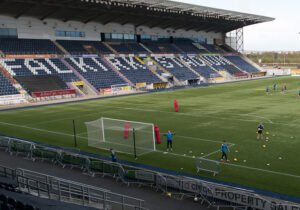
As part of my role as Scottish correspondent for Groundtastic magazine I wrote a number of club articles dedicated to a particular stadium. I hugely enjoyed visiting new towns and cities to unearth some architectural gems of the football world. As a roving reporter I visited Tynecastle, Firs Park, Caledonian Stadium, Victoria Park, Borough Briggs, and completed a tour of the football grounds of the Highland League to name but a few.
I have recently been watching the vlogs of Footy Adventures, which I would heartily recommend to those of you who are interested in football stadiums and architecture. These vlogs are exactly the sort of thing that I would have been producing if things were different. Sadly, I have been held back by a progressive, genetic disease of the nervous system, the related disability, a lack of technical expertise to produce videos and being in Scotland at the wrong time, with the wrong person.
I suppose what I have done as an alternative is to write Every Silver Lining has a Cloud, which is an autobiographical tour of the Welsh Premier League football grounds. For those who have yet to read it – shame on you. I am happy with my own contribution to the world of football architecture, but I can’t help having feelings of envy and jealousy as I watch the ever increasing body of vlogs produced by Footy Adventures.
I have decided to reproduce the club articles and photographs that I managed to take during my time in Scotland. This was a difficult time for myself as I was beginning to feel the full effects of living with Friedreich’s Ataxia. It would obviously difficult having to rely on trains to get me to my desired destination and the fact that I was losing my dexterity meant that it was increasingly difficult to take decent photographs.
I have been unable to locate some of the photographs that I took while in Scotland. Should you need proof, then you only have to find a copy of Groundtastic to see that I have been credited for taking some photos. For the purposes of this blog about Falkirk Stadium, I have used some of my photographs along with others that I have found on the internet. These photos are of a high standard, and I do not claim to have produced these myself. Where possible, I have included links to the original pages where I found these photos. Simply click on the photos to be redirected to the page where I found the originals.
Overall, I am happy with what I wrote, and hope the following is of interest to some of you.
***

After escaping the cramped confines of Brockvlle Park and spending a season sharing with Stenhousemuir at Ochilview, the Bairns finally opened the doors to their new home on July 25 for a pre-season friendly against Dundee.
The Falkirk Stadium is situated on the outskirts of the town and is easily accessible from the M9. At the moment only one stand is completed but the club are rightly proud of this impressive, cantilever structure, which has a seated capacity of 4,200. Named the West Stand, it includes a row of floodlights along the top of the roof. An Italian firm that specialises in stadium lighting were used to set the beams to ensure they comply with UEFA guidelines. The stand also includes club offices, conference facilities, executive boxes, suites and catering facilities.

At the moment, fencing surrounds the other three sides of the ground resulting in a lack of atmosphere. However, progress is being made behind the fences as foundations have been laid and work is progressing on the North Stand. This second stand will house 2,200 and it is hoped it will be ready by December 2004. In the meantime, the club will erect a temporary stand for visiting supporters.
Once the North Stand is completed work will continue on the two empty sides with the construction of stands that mirror their cross-field counterparts in capacity and design. However, this is dependent on Falkirk and its joint venture partners securing the necessary finance. When fully completed the overall capacity will be 12,800.
While work is ongoing, the stadium includes two floodlight pylons with thirty lamps each. These will be removed after completion of the East Stand, which will have similar roof-lights to the main West Stand.
One hidden feature of the new ground at Westfield is the sophisticated undersoil heating. A zonal system is used, whereby designated areas of the pitch can be protected when needed. The system was pioneered at Middlesbrough’s Riverside Stadium.
Unfortunately, the opening game at the stadium included some teething problems. For example the public address system was unclear, the tap pressure in the toilets was too strong and the queues for refreshments were excessive. However, the biggest problem that needs urgent attention is the issue of car parking, which led to a 10-minute delay to the kick-off. The problem originated with cars being parked leaving too large a distance between rows as spaces were unmarked. It is clear however, that even with more efficient parking arrangements, the car parks will not accommodate the total number of cars that require to be parked. Falkirk is looking at alternative sites for an overflow facility but already they are encouraging people to car share.
On a more positive note the stadium has already been awarded an international match when Scotland Under 17’s take on their counterparts from the Faroe Islands in October. It maybe a long time before the stadium is ready to hold a full international, but there is no doubt that if the current progress, innovation and standards are maintained, international football will eventually find a new home at Falkirk Stadium.
***
Twenty odd years after I had written the Groundtastic article on Falkirk Stadium, a YouTube vlogger produced the following video as part of his tour around Scottish football grounds. Check out the impressive array of football ground vlogs produced by Footy Adventures by clicking here.

